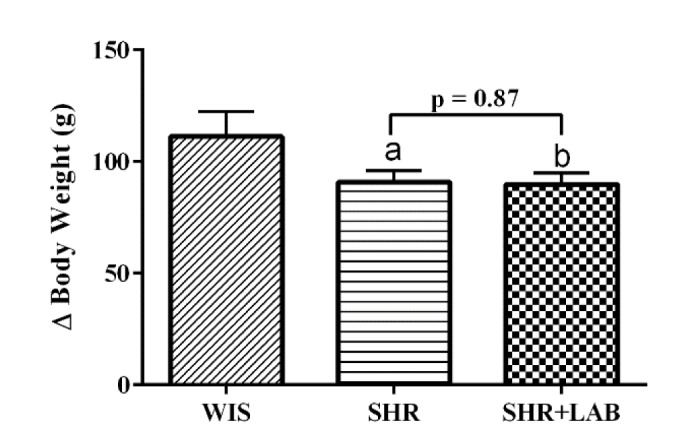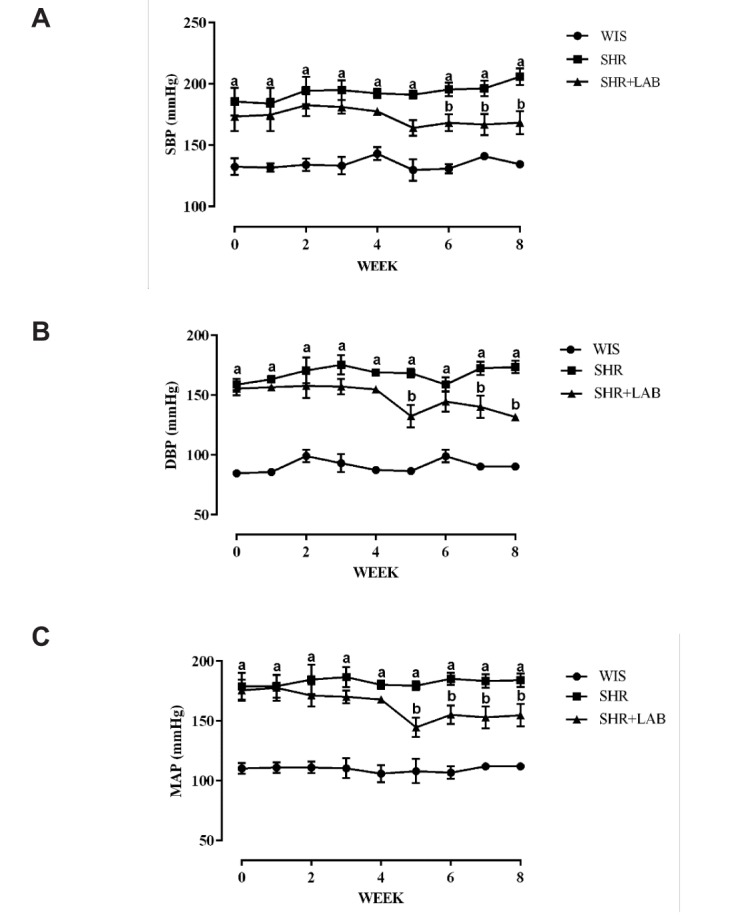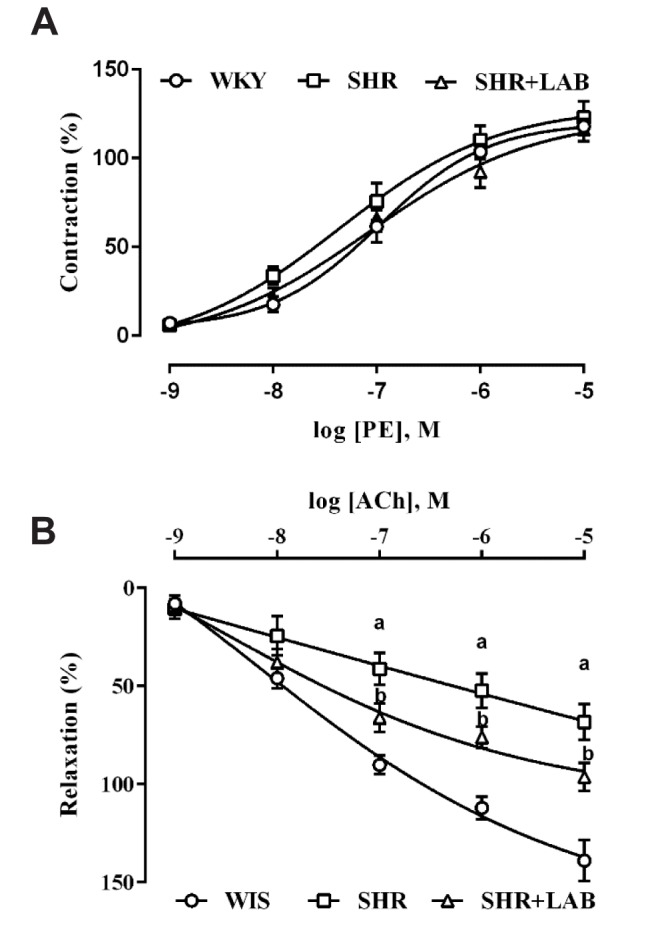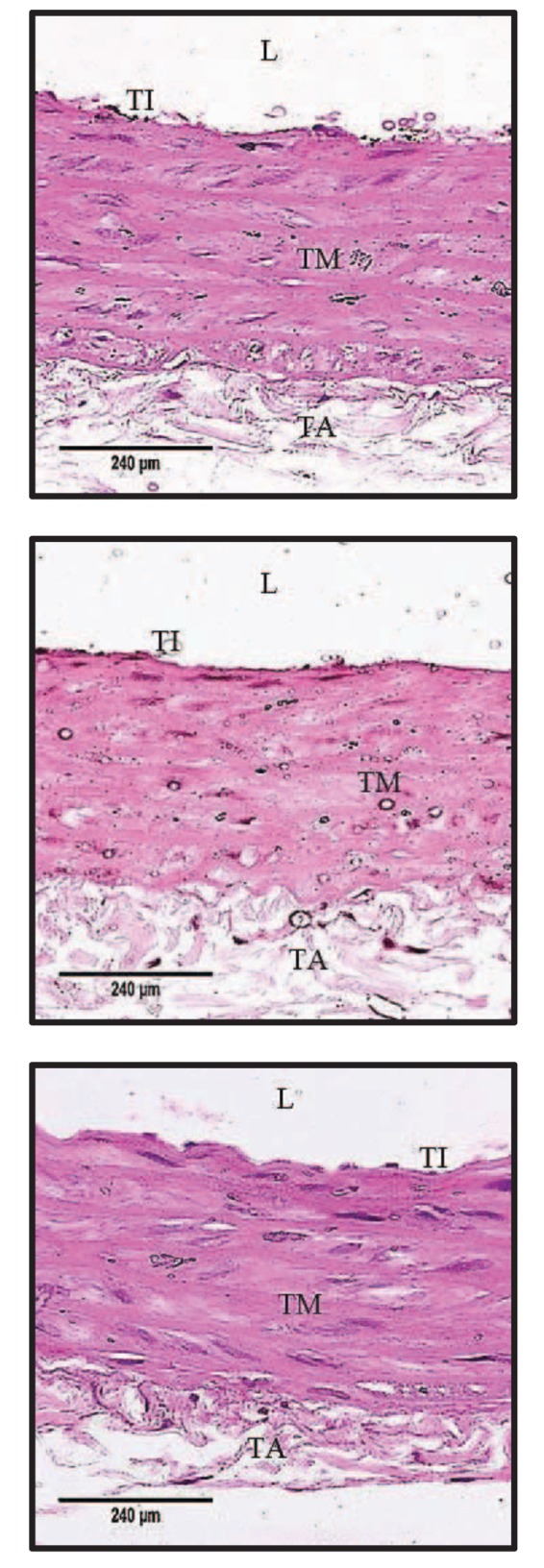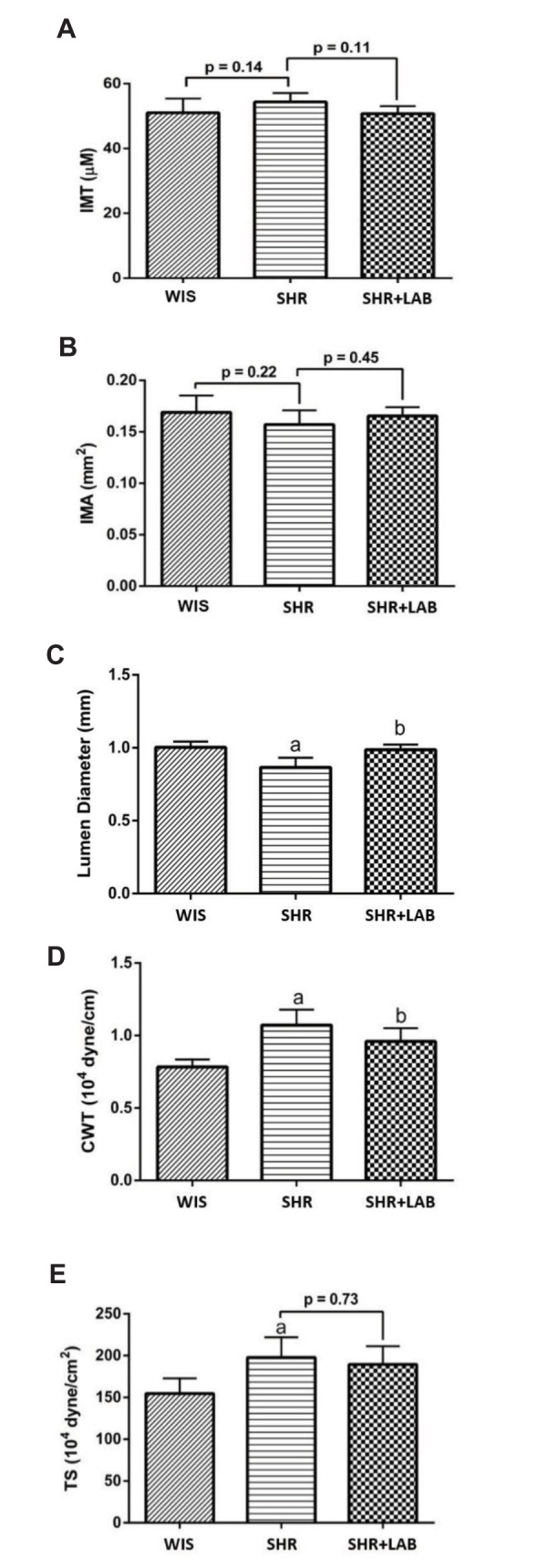Korean J Physiol Pharmacol.
2016 Nov;20(6):621-628. 10.4196/kjpp.2016.20.6.621.
Lactobacillus casei strain C1 attenuates vascular changes in spontaneously hypertensive rats
- Affiliations
-
- 1Programme of Biomedical Sciences, School of Diagnostic and Applied Health Sciences, Faculty of Health Sciences, Universiti Kebangsaan Malaysia, Kuala Lumpur 50300, Malaysia. satirah@ukm.edu.my
- KMID: 2364266
- DOI: http://doi.org/10.4196/kjpp.2016.20.6.621
Abstract
- Hypertension can be caused by various factors while the predominant causes include increase in body fluid volume and resistance in the circulatory system that elevate the blood pressure. Consumption of probiotics has been proven to attenuate hypertension; however, the effect is much strain-dependent. In this study, a newly isolated Lactobacillus casei (Lb. casei) strain C1 was investigated for its antihypertensive properties in spontaneously hypertensive rats (SHR). Lactic acid bacteria (LAB) suspension of 11 log colony-forming unit (CFU) was given to SHR (SHR+LAB, n=8), and phosphate buffer saline (PBS) was given as a control in SHR (SHR, n=8) and in Wistar rats as sham (WIS, n=8). The treatment was given via oral gavage for 8 weeks. The results showed that the weekly systolic blood pressure (SBP), mean arterial pressure (MAP), diastolic blood pressure (DBP) and aortic reactivity function were remarkably improved after 8 weeks of bacterial administration in SHR+LAB. These effects were mostly attributed by restoration of wall tension and tensile stress following the bacterial treatment. Although not statistically significant, the level of malondialdehye (MDA) in SHR+LAB serum was found declining. Increased levels of glutathione (GSH) and nitric oxide (NO) in SHR+LAB serum suggested that the bacterium exerted vascular protection through antioxidative functions and relatively high NO level that induced vasodilation. Collectively, Lb. casei strain C1 is a promising alternative for hypertension improvement.
MeSH Terms
Figure
Reference
-
1. Reid G, Charbonneau D, Erb J, Kochanowski B, Beuerman D, Poehner R, Bruce AW. Oral use of Lactobacillus rhamnosus GR-1 and L. fermentum RC-14 significantly alters vaginal flora: randomized, placebo-controlled trial in 64 healthy women. FEMS Immunol Med Microbiol. 2003; 35:131–134. PMID: 12628548.2. Ouwehand AC. Antiallergic effects of probiotics. J Nutr. 2007; 137(3 Suppl 2):794S–797S. PMID: 17311977.
Article3. Quigley EM. Probiotics in irritable bowel syndrome: an immunomodulatory strategy? J Am Coll Nutr. 2007; 26:684S–690S. PMID: 18187434.
Article4. Tappenden KA, Deutsch AS. The physiological relevance of the intestinal microbiota--contributions to human health. J Am Coll Nutr. 2007; 26:679S–683S. PMID: 18187433.5. Khalesi S, Sun J, Buys N, Jayasinghe R. Effect of probiotics on blood pressure: a systematic review and meta-analysis of randomized, controlled trials. Hypertension. 2014; 64:897–903. PMID: 25047574.6. Forsyth CB, Farhadi A, Jakate SM, Tang Y, Shaikh M, Keshavarzian A. Lactobacillus GG treatment ameliorates alcohol-induced intestinal oxidative stress, gut leakiness, and liver injury in a rat model of alcoholic steatohepatitis. Alcohol. 2009; 43:163–172. PMID: 19251117.
Article7. Galdeano CM, Perdigón G. The probiotic bacterium Lactobacillus casei induces activation of the gut mucosal immune system through innate immunity. Clin Vaccine Immunol. 2006; 13:219–226. PMID: 16467329.8. Yap WB, Sujang R, Tan TS. Identification and characterization of Lactic Acid Bacteria (LAB) isolated from probiotic drinks in Malaysia. J Sains Kesihatan Malaysia. 2015; 13:23–31.
Article9. Persell SD1. Prevalence of resistant hypertension in the United States, 2003-2008. Hypertension. 2011; 57:1076–1080. PMID: 21502568.
Article10. Laurent S, Katsahian S, Fassot C, Tropeano AI, Gautier I, Laloux B, Boutouyrie P. Aortic stiffness is an independent predictor of fatal stroke in essential hypertension. Stroke. 2003; 34:1203–1206. PMID: 12677025.
Article11. Zainalabidin S, Budin SB, Ramalingam A, Lim YC. Aortic remodelling in chronic nicotine-administered rat. Korean J Physiol Pharmacol. 2014; 18:411–418. PMID: 25352761.
Article12. Bellien J, Favre J, Iacob M, Gao J, Thuillez C, Richard V, Joannidès R. Arterial stiffness is regulated by nitric oxide and endothelium-derived hyperpolarizing factor during changes in blood flow in humans. Hypertension. 2010; 55:674–680. PMID: 20083732.
Article13. Agerholm-Larsen L, Raben A, Haulrik N, Hansen AS, Manders M, Astrup A. Effect of 8 week intake of probiotic milk products on risk factors for cardiovascular diseases. Eur J Clin Nutr. 2000; 54:288–297. PMID: 10745279.
Article14. Naruszewicz M, Johansson ML, Zapolska-Downar D, Bukowska H. Effect of Lactobacillus plantarum 299v on cardiovascular disease risk factors in smokers. Am J Clin Nutr. 2002; 76:1249–1255. PMID: 12450890.
Article15. Lin PP, Hsieh YM, Kuo WW, Lin YM, Yeh YL, Lin CC, Tsai FJ, Tsai CH, Huang CY, Tsai CC. Probiotic-fermented purple sweet potato yogurt activates compensatory IGF-IR/PI3K/Akt survival pathways and attenuates cardiac apoptosis in the hearts of spontaneously hypertensive rats. Int J Mol Med. 2013; 32:1319–1328. PMID: 24127171.
Article16. Rowland I, Capurso L, Collins K, Cummings J, Delzenne N, Goulet O, Guarner F, Marteau P, Meier R. Current level of consensus on probiotic science--report of an expert meeting--London, 23 November 2009. Gut Microbes. 2010; 1:436–439. PMID: 21637035.17. Leelarungrayub D, Sawattikanon N, Klaphajone J, Pothongsunan P, Bloomer RJ. Coenzyme Q10 supplementation decreases oxidative stress and improves physical performance in young swimmers: a pilot study. Open Sports Med J. 2010; 4:1–8.
Article18. Stocks J, Dormandy TL. The autoxidation of human red cell lipids induced by hydrogen peroxide. Br J Haematol. 1971; 20:95–111. PMID: 5540044.
Article19. Ellman GL. Tissue sulfhydryl groups. Arch Biochem Biophys. 1959; 82:70–77. PMID: 13650640.
Article20. Fernandes-Santos C, de Souza Mendonça L, Mandarim-de-Lacerda CA. Favorable cardiac and aortic remodeling in olmesartan-treated spontaneously hypertensive rats. Heart Vessels. 2009; 24:219–227. PMID: 19466524.
Article21. Lye HS, Kuan CY, Ewe JA, Fung WY, Liong MT. The improvement of hypertension by probiotics: effects on cholesterol, diabetes, renin, and phytoestrogens. Int J Mol Sci. 2009; 10:3755–3775. PMID: 19865517.
Article22. Toral M, Gómez-Guzmán M, Jiménez R, Romero M, Sánchez M, Utrilla MP, Garrido-Mesa N, Rodríguez-Cabezas ME, Olivares M, Gálvez J, Duarte J. The probiotic Lactobacillus coryniformis CECT5711 reduces the vascular pro-oxidant and pro-inflammatory status in obese mice. Clin Sci (Lond). 2014; 127:33–45. PMID: 24410749.23. Gobbetti M, Ferranti P, Smacchi E, Goffredi F, Addeo F. Production of angiotensin-I-converting-enzyme-inhibitory peptides in fermented milks started by Lactobacillus delbrueckii subsp. bulgaricus SS1 and Lactococcus lactis subsp. cremoris FT4. Appl Environ Microbiol. 2000; 66:3898–3904. PMID: 10966406.24. Klahr S. The role of nitric oxide in hypertension and renal disease progression. Nephrol Dial Transplant. 2001; 16(Suppl 1):60–62.
Article25. Guo Z, Wang J, Yan L, Chen W, Liu X, Zhang H. In vitro comparison of probiotic properties of Lactobacillus casei Zhang, a potential new probiotic, with selected probiotic strains. LWT-Food Sci Technol. 2009; 42:1640–1646.26. Ran X, Zhao W, Li W, Shi J, Chen X. Cryptotanshinone inhibits TNF-α-induced LOX-1 expression by suppressing reactive oxygen species (ROS) formation in endothelial cells. Korean J Physiol Pharmacol. 2016; 20:347–355. PMID: 27382351.
Article27. Nohara R, Daida H, Hata M, Kaku K, Kawamori R, Kishimoto J, Kurabayashi M, Masuda I, Sakuma I, Yamazaki T, Yokoi H, Yoshida M. Effect of long-term intensive lipid-lowering therapy with rosuvastatin on progression of carotid intima-media thickness--Justification for Atherosclerosis Regression Treatment (JART) extension study. Circ J. 2013; 77:1526–1533. PMID: 23486191.28. Lutgendorff F, Trulsson LM, van Minnen LP, Rijkers GT, Timmerman HM, Franzén LE, Gooszen HG, Akkermans LM, Söderholm JD, Sandström PA. Probiotics enhance pancreatic glutathione biosynthesis and reduce oxidative stress in experimental acute pancreatitis. Am J Physiol Gastrointest Liver Physiol. 2008; 295:G1111–G1121. PMID: 18832452.
Article
- Full Text Links
- Actions
-
Cited
- CITED
-
- Close
- Share
- Similar articles
-
- Lactobacillus casei subspecies casei endocarditis: a case report
- The effects of three novel probiotics isolated from the Korean fermented food Kimchi on the stress-induced defecation of rats
- Comparison of Lactobacillus casei in Stool between Children with Atopic Dermatitis and Normal Controls
- Effects of Lactobacillus casei and Aggregatibactor actinomycetemcomitans against Streptococcus mutans according to the Concentration of Sucrose
- Antifungal Activity of Lactic Acid Bacteria Isolated from Kimchi Against Aspergillus fumigatus

